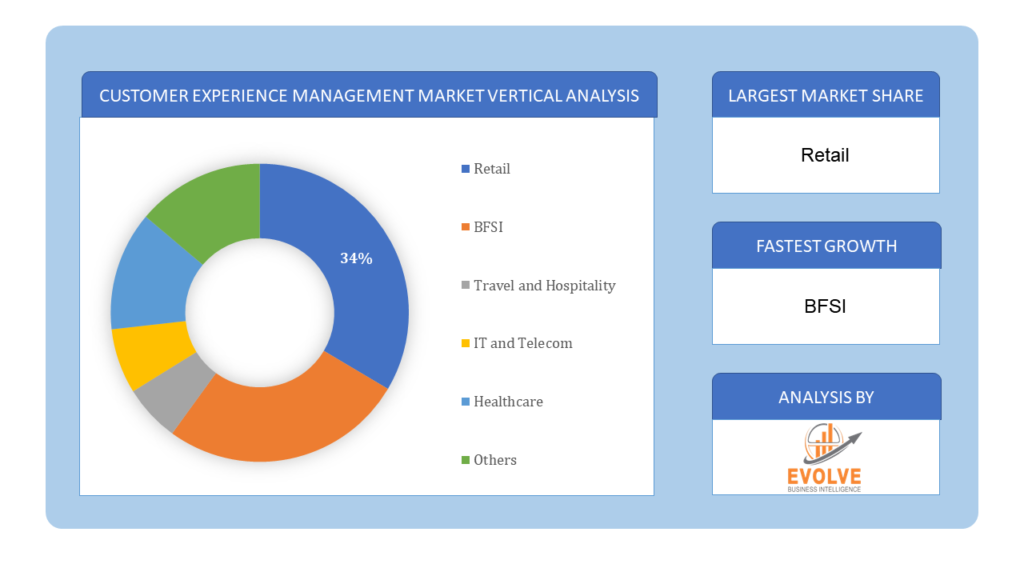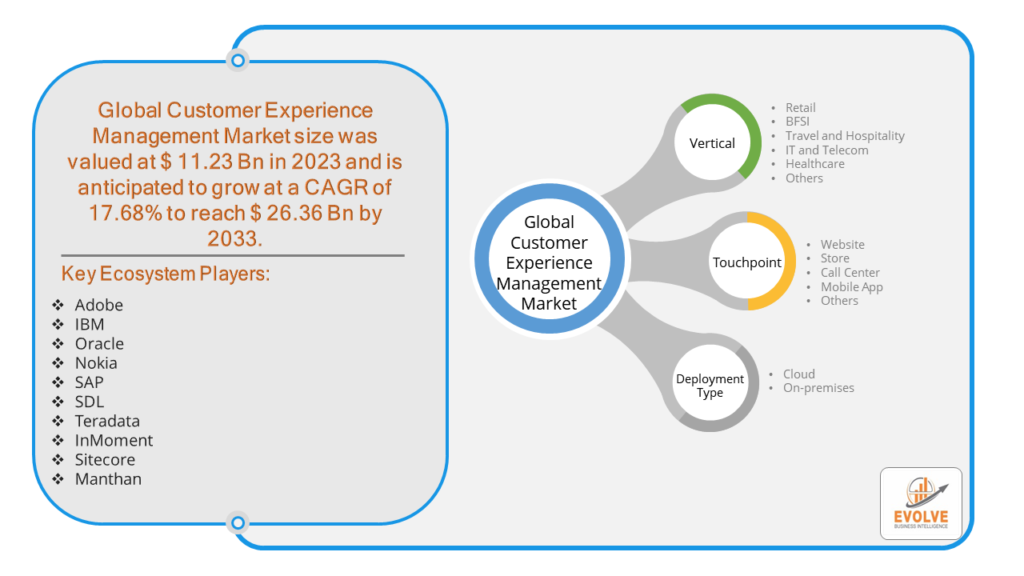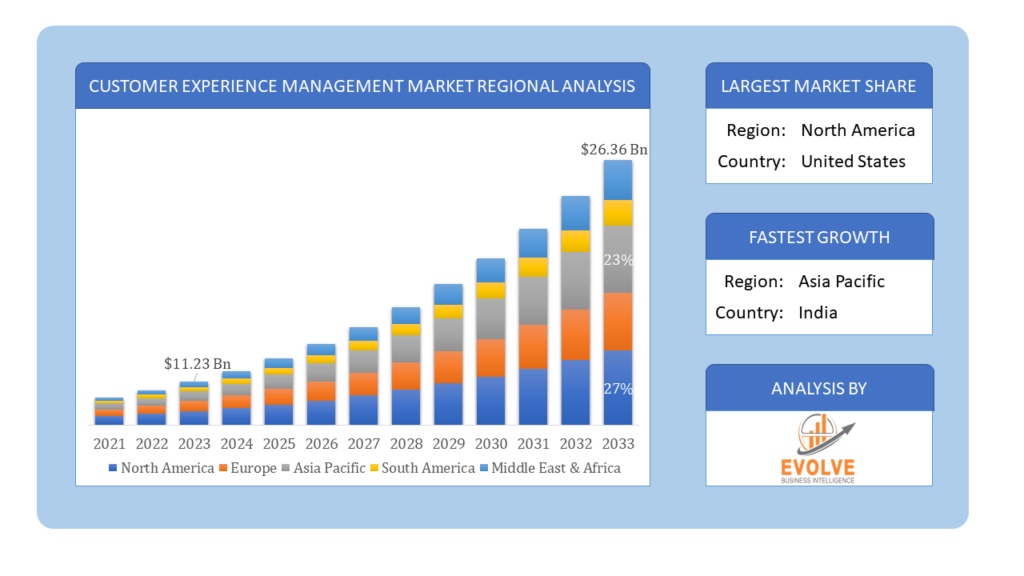Customer Experience Management Market Analysis and Global Forecast 2023-2033
$ 1,390.00 – $ 5,520.00Price range: $ 1,390.00 through $ 5,520.00
Customer Experience Management Market Research Report: Information By Vertical (Retail, BFSI, Travel and Hospitality, IT and Telecom, Healthcare, Others), By Touchpoint (Website, Store, Call Center, Mobile App, Others), By Deployment Type (Cloud, On-premises), and by Region — Forecast till 2033
Page: 175
Customer Experience Management Market Overview
The Customer Experience Management Market Size is expected to reach USD 26.36 Billion by 2033. The Customer Experience Management Market industry size accounted for USD 11.23 Billion in 2023 and is expected to expand at a compound annual growth rate (CAGR) of 17.68% from 2023 to 2033. Customer Experience Management (CEM or CXM) is the strategic approach to understanding, tracking, and improving the interactions and experiences customers have with a company throughout their entire journey. This involves gathering and analyzing customer feedback, leveraging data and analytics, and implementing processes and technologies to enhance every touchpoint across various channels. The goal of CEM is to build strong customer relationships, increase satisfaction and loyalty, and ultimately drive business growth by consistently meeting or exceeding customer expectations.
Global Customer Experience Management Market Synopsis
The COVID-19 pandemic had a significant impact on the Customer Experience Management Market. It accelerated the adoption of digital channels as businesses shifted to remote operations and online customer interactions. This shift underscored the importance of robust digital customer experience strategies, prompting companies to invest in advanced CEM tools and technologies to maintain customer engagement and satisfaction. Additionally, the pandemic highlighted the need for empathetic and responsive customer service, driving innovations in personalized and real-time support solutions.
Customer Experience Management Market Dynamics
The major factors that have impacted the growth of Customer Experience Management Market are as follows:
Drivers:
Ø Increasing Importance of Customer Retention and Loyalty
Businesses are increasingly prioritizing customer retention and loyalty as key components of their growth strategies. Positive customer experiences are directly linked to higher customer retention rates and brand loyalty. Companies recognize that satisfied customers are more likely to make repeat purchases and advocate for the brand through positive word-of-mouth and social media. As a result, there is a growing demand for Customer Experience Management (CEM) solutions that help organizations understand customer needs, track satisfaction levels, and address issues proactively. This focus on enhancing customer experiences drives the adoption of CEM tools and practices across various industries.
Restraint:
- High Implementation Costs
Implementing comprehensive CEM solutions can be a costly endeavor. The expenses associated with deploying advanced technologies, such as customer relationship management (CRM) systems, data analytics platforms, and artificial intelligence (AI) tools, can be substantial. Additionally, the need for skilled personnel to manage and analyze customer data, along with the costs of employee training and process reengineering, further adds to the financial burden. For small and medium-sized enterprises (SMEs) with limited budgets, these high implementation costs can be a significant barrier, making it challenging to invest in and fully leverage CEM solutions.
Opportunity:
⮚ Advancements in AI and Analytics
The rapid advancements in artificial intelligence (AI) and data analytics present significant opportunities for the Customer Experience Management market. AI-driven solutions can analyze vast amounts of customer data in real-time, providing actionable insights into customer preferences, behaviors, and sentiment. Predictive analytics can forecast future customer needs and trends, enabling businesses to tailor their offerings and marketing strategies accordingly. Personalized customer interactions, driven by AI, can enhance engagement and satisfaction by delivering relevant and timely content, recommendations, and support. These technological advancements empower organizations to create more meaningful and effective customer experiences, driving the demand for AI and analytics-based CEM solutions.
Customer Experience Management Market Segment Overview
By Vertical
 Based on Vertical, the market is segmented based on Retail, BFSI, Travel and Hospitality, IT and Telecom, Healthcare, Others. The Retail segment dominates the Customer Experience Management Market due to its focus on enhancing customer satisfaction and loyalty through personalized shopping experiences. Retailers are increasingly investing in CEM solutions to understand customer preferences and behavior better, which helps them offer tailored promotions and seamless omnichannel experiences. This focus on customer-centric strategies drives the adoption of advanced CEM tools in the retail sector.
Based on Vertical, the market is segmented based on Retail, BFSI, Travel and Hospitality, IT and Telecom, Healthcare, Others. The Retail segment dominates the Customer Experience Management Market due to its focus on enhancing customer satisfaction and loyalty through personalized shopping experiences. Retailers are increasingly investing in CEM solutions to understand customer preferences and behavior better, which helps them offer tailored promotions and seamless omnichannel experiences. This focus on customer-centric strategies drives the adoption of advanced CEM tools in the retail sector.
By Touchpoint
Based on Touchpoint, the market segment has been divided into the Website, Store, Call Center, Mobile App, Others. The Website segment dominates the Customer Experience Management Market due to its critical role in providing first impressions and engaging with customers. Businesses are investing heavily in optimizing website experiences to ensure user satisfaction, streamline navigation, and personalize content. This emphasis on enhancing website interactions drives the adoption of advanced CEM tools and strategies.
By Deployment Type
Based on Deployment Type, the market segment has been divided into the Cloud, On-premises. The Cloud segment dominates the Customer Experience Management Market. Its dominance is driven by the scalability, flexibility, and cost-effectiveness that cloud solutions offer, allowing businesses to deploy and manage CEM tools more efficiently. The ability to access real-time data and analytics from anywhere further enhances customer experience strategies, making cloud-based solutions a preferred choice for many organizations.
Global Customer Experience Management Market Regional Analysis
Based on region, the global Customer Experience Management Market has been divided into North America, Europe, Asia-Pacific, the Middle East & Africa, and Latin America. North America is projected to dominate the use of the Customer Experience Management Market followed by the Asia-Pacific and Europe regions.
 Customer Experience Management North America Market
Customer Experience Management North America Market
North America holds a dominant position in the Customer Experience Management Market due to several factors. The region’s strong technological infrastructure and high adoption rates of advanced digital solutions facilitate the implementation of sophisticated CEM strategies. Additionally, North America is home to numerous leading CEM solution providers and innovative startups, fostering a competitive environment that drives continuous advancements in customer experience technologies. The region’s businesses place a high emphasis on customer satisfaction and loyalty, investing significantly in tools and practices that enhance customer interactions across various touchpoints. Furthermore, the presence of a large and diverse consumer base with high expectations for personalized and seamless experiences further bolsters the demand for effective CEM solutions in North America.
Customer Experience Management Asia-Pacific Market
The Asia-Pacific region has indeed emerged as the fastest-growing market for the Customer Experience Management (CEM) industry. This growth is driven by rapid digital transformation, increasing internet and smartphone penetration, and a burgeoning middle-class population with rising expectations for superior customer experiences. Additionally, the region’s diverse and competitive business landscape, coupled with significant investments in technology and innovation, has led to the adoption of advanced CEM solutions. Companies in Asia-Pacific are increasingly focusing on enhancing customer satisfaction and loyalty to gain a competitive edge, further propelling the growth of the CEM market in the region.
Competitive Landscape
The global Customer Experience Management Market is highly competitive, with numerous players offering a wide range of software solutions. The competitive landscape is characterized by the presence of established companies, as well as emerging startups and niche players. To increase their market position and attract a wide consumer base, the businesses are employing various strategies, such as product launches, and strategic alliances.
Prominent Players:
- Adobe
- IBM
- Oracle
- Nokia
- SAP
- SDL
- Teradata
- InMoment
- Sitecore
- Manthan
Key Development
In March 2022, Adobe announced the general availability of Adobe Experience Cloud for Healthcare, a service designed to help healthcare businesses deliver personalized and secure digital experiences to their customers. With this service, healthcare providers can offer patients a range of options for monitoring their treatment. Patients can inform providers of their preferred communication channels, such as receiving appointment reminders or care management suggestions via text or email.
Scope of the Report
Global Customer Experience Management Market, by Vertical
- Retail
- BFSI
- Travel and Hospitality
- IT and Telecom
- Healthcare
- Others
Global Customer Experience Management Market, by Touchpoint
- Website
- Store
- Call Center
- Mobile App
- Others
Global Customer Experience Management Market, by Deployment Type
- Cloud
- On-premises
Global Customer Experience Management Market, by Region
- North America
- US
- Canada
- Mexico
- Europe
- UK
- Germany
- France
- Italy
- Spain
- Benelux
- Nordic
- Rest of Europe
- Asia Pacific
- China
- Japan
- South Korea
- Indonesia
- Austalia
- Malaysia
- India
- Rest of Asia Pacific
- South America
- Brazil
- Argentina
- Rest of South America
- Middle East & Africa
- Saudi Arabia
- UAE
- Egypt
- South Africa
- Rest of Middle East & Africa
| Parameters | Indicators |
|---|---|
| Market Size | 2033: $26.36 Billion/strong> |
| CAGR | 17.68% CAGR (2023-2033) |
| Base year | 2022 |
| Forecast Period | 2023-2033 |
| Historical Data | 2021 |
| Report Coverage | Revenue Forecast, Competitive Landscape, Growth Factors, and Trends |
| Key Segmentations | Vertical, Touchpoint, Deployment Type |
| Geographies Covered | North America, Europe, Asia-Pacific, Latin America, Middle East, Africa |
| Key Vendors | Adobe, IBM, Oracle, Nokia, SAP, SDL, Teradata, InMoment, Sitecore, Manthan |
| Key Market Opportunities | • Advancements in AI and analytics • Expansion of omnichannel customer engagement strategies • Rising adoption of cloud-based CEM solutions |
| Key Market Drivers | • Increasing importance of customer retention and loyalty • Rapid digital transformation and adoption of advanced technologies • Growing demand for personalized customer experiences |
REPORT CONTENT BRIEF:
- High-level analysis of the current and future Customer Experience Management Market trends and opportunities
- Detailed analysis of current market drivers, restraining factors, and opportunities in the future
- Customer Experience Management Market historical market size for the year 2021, and forecast from 2023 to 2033
- Customer Experience Management Market share analysis at each product level
- Competitor analysis with detailed insight into its product segment, Government & Defense strength, and strategies adopted.
- Identifies key strategies adopted including product launches and developments, mergers and acquisitions, joint ventures, collaborations, and partnerships as well as funding taken and investment done, among others.
- To identify and understand the various factors involved in the global Customer Experience Management Market affected by the pandemic
- To provide a detailed insight into the major companies operating in the market. The profiling will include the Government & Defense health of the company’s past 2-3 years with segmental and regional revenue breakup, product offering, recent developments, SWOT analysis, and key strategies.
Press Release

Global Pharmaceutical Manufacturing Market to Reach $1.38 Trillion by 2035 with 7.35% CAGR, New Research Shows

The Global Mammography Market Is Estimated To Record a CAGR of Around 10.29% During The Forecast Period

Glue Stick Market to Reach USD 2.35 Billion by 2034

Podiatry Service Market to Reach USD 11.88 Billion by 2034

Microfluidics Technology Market to Reach USD 32.58 Billion by 2034

Ferric Chloride Market to Reach USD 10.65 Billion by 2034

Family Practice EMR Software Market to Reach USD 21.52 Billion by 2034

Electric Hairbrush Market to Reach USD 15.95 Billion by 2034

Daily Bamboo Products Market to Reach USD 143.52 Billion by 2034

Cross-border E-commerce Logistics Market to Reach USD 112.65 Billion by 2034
Frequently Asked Questions (FAQ)
1.What is the study period of this market?
- The study period of the global Customer Experience Management Market is 2021- 2033
2.What is the growth rate of the global Customer Experience Management Market?
- The global Customer Experience Management Market is growing at a CAGR of 17.68% over the next 10 years
3.Which region has the highest growth rate in the market of Customer Experience Management Market?
- Asia Pacific is expected to register the highest CAGR during 2023-2033
4.Which region has the largest share of the global Customer Experience Management Market?
- North America holds the largest share in 2022
5.Who are the key players in the global Customer Experience Management Market?
Adobe, IBM, Oracle, Nokia, SAP, SDL, Teradata, InMoment, Sitecore, Manthan are the major companies operating in the market
6.Do you offer Post Sale Support?
- Yes, we offer 16 hours of analyst support to solve the queries
7.Do you sell particular sections of a report?
Yes, we provide regional as well as country-level reports. Other than this we also provide a sectional report. Please get in contact with our sales representatives
Table of Content
CHAPTER 1. Executive Summary CHAPTER 2. Scope of the Study 2.1. Market Definition 2.2. Market Scope & Segmentation 2.2.1. Objective of Report CHAPTER 3. Evolve BI Methodology 3.1. Data Collection & Validation Approach 3.2. Market Size Estimation and Forecast CHAPTER 4. Exclusive Analysis 4.1. Market Opportunity Score 4.1.1. Vertical Segement – Market Opportunity Score 4.1.2. Touchpoint Segment – Market Opportunity Score 4.1.3. Deployment Type Segment – Market Opportunity Score 4.2. Key Market Influencing Indicators CHAPTER 5. Market Insights and Trends 5.1. Value Chain Analysis 5.1.1. Raw Material 5.1.2. Manufacturing Process 5.1.3. Distribution Channel 5.1.4. End User 5.2. Porter’s Five Forces Analysis 5.2.1. Bargaining Power of Buyers 5.2.2. Bargaining Power of Suppliers 5.2.3. Threat of New Entrant 5.2.4. Threat of Substitute 5.2.5. Industry Rivalry 5.3. COVID-19 Impact and Post COVID Scenario on Customer Experience Management Market 5.3.1. Impact of COVID-19 5.3.2. Government Support and Industry Revival Policies 5.3.3. Measures Taken by Companies to Mitigate Negative Impact 5.3.4. Post COVID Trend CHAPTER 6. Market Dynamics 6.1. Introduction 6.2. Drivers 6.2.1. Driver 1 6.2.2. Driver 2 6.2.3. Driver 3 6.3. Restraints 6.3.1. Restraint 1 6.3.2. Restraint 2 6.4. Opportunity 6.4.1. Opportunity 1 CHAPTER 7. Customer Experience Management Market, By Vertical 7.1. Introduction 7.1.1. Retail 7.1.2. BFSI 7.1.3. Travel and Hospitality 7.1.4. IT and Telecom 7.1.5. Healthcare 7.1.6. Others CHAPTER 8 Customer Experience Management Market, By Touchpoint 8.1. Introduction 8.1.1. Website 8.1.2. Store 8.1.3. Call Center 8.1.4. Mobile App 8.1.5. Other CHAPTER 9. Customer Experience Management Market, By Deployment Type 9.1. Introduction 9.1.1. Cloud 9.1.2. On-premises CHAPTER 10. Customer Experience Management Market, By Region 10.1. Introduction 10.2. NORTH AMERICA 10.2.1. North America: Market Size and Forecast, By Country, 2023 – 2033 ($ Million) 10.2.2. North America: Market Size and Forecast, By Vertical, 2023 – 2033 ($ Million) 10.2.3. North America: Market Size and Forecast, By Touchpoint, 2023 – 2033 ($ Million) 10.2.4. North America: Market Size and Forecast, By Deployment Type, 2023 – 2033 ($ Million) 10.2.5. US 10.2.5.1. US: Market Size and Forecast, By Vertical, 2023 – 2033 ($ Million) 10.2.5.2. US: Market Size and Forecast, By Touchpoint, 2023 – 2033 ($ Million) 10.2.5.3. US: Market Size and Forecast, By Deployment Type, 2023 – 2033 ($ Million) 10.2.6. CANADA 10.2.6.1. Canada: Market Size and Forecast, By Vertical, 2023 – 2033 ($ Million) 10.2.6.2. Canada: Market Size and Forecast, By Touchpoint, 2023 – 2033 ($ Million) 10.2.6.3. Canada: Market Size and Forecast, By Deployment Type, 2023 – 2033 ($ Million) 10.2.7. MEXICO 10.2.7.1. Mexico: Market Size and Forecast, By Vertical, 2023 – 2033 ($ Million) 10.2.7.2. Mexico: Market Size and Forecast, By Touchpoint, 2023 – 2033 ($ Million) 10.2.7.3. Mexico: Market Size and Forecast, By Deployment Type, 2023 – 2033 ($ Million) 10.3. Europe 10.3.1. Europe: Market Size and Forecast, By Country, 2023 – 2033 ($ Million) 10.3.2. Europe: Market Size and Forecast, By Vertical, 2023 – 2033 ($ Million) 10.3.3. Europe: Market Size and Forecast, By Touchpoint, 2023 – 2033 ($ Million) 10.3.4. Europe: Market Size and Forecast, By Deployment Type, 2023 – 2033 ($ Million) 10.3.5. U.K. 10.3.5.1. U.K.: Market Size and Forecast, By Vertical, 2023 – 2033 ($ Million) 10.3.5.2. U.K.: Market Size and Forecast, By Touchpoint, 2023 – 2033 ($ Million) 10.3.5.3. U.K.: Market Size and Forecast, By Deployment Type, 2023 – 2033 ($ Million) 10.3.6. GERMANY 10.3.6.1. Germany: Market Size and Forecast, By Vertical, 2023 – 2033 ($ Million) 10.3.6.2. Germany: Market Size and Forecast, By Touchpoint, 2023 – 2033 ($ Million) 10.3.6.3. Germany: Market Size and Forecast, By Deployment Type, 2023 – 2033 ($ Million) 10.3.7. FRANCE 10.3.7.1. France: Market Size and Forecast, By Vertical, 2023 – 2033 ($ Million) 10.3.7.2. France: Market Size and Forecast, By Touchpoint, 2023 – 2033 ($ Million) 10.3.7.3. France: Market Size and Forecast, By Deployment Type, 2023 – 2033 ($ Million) 10.3.8. ITALY 10.3.8.1. Italy: Market Size and Forecast, By Vertical, 2023 – 2033 ($ Million) 10.3.8.2. Italy: Market Size and Forecast, By Touchpoint, 2023 – 2033 ($ Million) 10.3.8.3. Italy: Market Size and Forecast, By Deployment Type, 2023 – 2033 ($ Million) 10.3.9. SPAIN 10.3.9.1. Spain: Market Size and Forecast, By Vertical, 2023 – 2033 ($ Million) 10.3.9.2. Spain: Market Size and Forecast, By Touchpoint, 2023 – 2033 ($ Million) 10.3.9.3. Spain: Market Size and Forecast, By Deployment Type, 2023 – 2033 ($ Million) 10.3.10. BENELUX 10.3.10.1. BeNeLux: Market Size and Forecast, By Vertical, 2023 – 2033 ($ Million) 10.3.10.2. BeNeLux: Market Size and Forecast, By Touchpoint, 2023 – 2033 ($ Million) 10.3.10.3. BeNeLux: Market Size and Forecast, By Deployment Type, 2023 – 2033 ($ Million) 10.3.11. RUSSIA 10.3.11.1. Russia: Market Size and Forecast, By Vertical, 2023 – 2033 ($ Million) 10.3.11.2. Russia: Market Size and Forecast, By Touchpoint, 2023 – 2033 ($ Million) 10.3.11.3. Russia: Market Size and Forecast, By Deployment Type, 2023 – 2033 ($ Million) 10.3.12. REST OF EUROPE 10.3.12.1. Rest of Europe: Market Size and Forecast, By Vertical, 2023 – 2033 ($ Million) 10.3.12.2. Rest of Europe: Market Size and Forecast, By Touchpoint, 2023 – 2033 ($ Million) 10.3.12.3. Rest of Europe: Market Size and Forecast, By Deployment Type, 2023 – 2033 ($ Million) 10.4. Asia Pacific 10.4.1. Asia Pacific: Market Size and Forecast, By Country, 2023 – 2033 ($ Million) 10.4.2. Asia Pacific: Market Size and Forecast, By Vertical, 2023 – 2033 ($ Million) 10.4.3. Asia Pacific: Market Size and Forecast, By Touchpoint, 2023 – 2033 ($ Million) 10.4.4. Asia Pacific: Market Size and Forecast, By Deployment Type, 2023 – 2033 ($ Million) 10.4.5. CHINA 10.4.5.1. China: Market Size and Forecast, By Vertical, 2023 – 2033 ($ Million) 10.4.5.2. China: Market Size and Forecast, By Touchpoint, 2023 – 2033 ($ Million) 10.4.5.3. China: Market Size and Forecast, By Deployment Type, 2023 – 2033 ($ Million) 10.4.6. JAPAN 10.4.6.1. Japan: Market Size and Forecast, By Vertical, 2023 – 2033 ($ Million) 10.4.6.2. Japan: Market Size and Forecast, By Touchpoint, 2023 – 2033 ($ Million) 10.4.6.3. Japan: Market Size and Forecast, By Deployment Type, 2023 – 2033 ($ Million) 10.4.7. INDIA 10.4.7.1. India: Market Size and Forecast, By Vertical, 2023 – 2033 ($ Million) 10.4.7.2. India: Market Size and Forecast, By Touchpoint, 2023 – 2033 ($ Million) 10.4.7.3. India: Market Size and Forecast, By Deployment Type, 2023 – 2033 ($ Million) 10.4.8. SOUTH KOREA 10.4.8.1. South Korea: Market Size and Forecast, By Vertical, 2023 – 2033 ($ Million) 10.4.8.2. South Korea: Market Size and Forecast, By Touchpoint, 2023 – 2033 ($ Million) 10.4.8.3. South Korea: Market Size and Forecast, By Deployment Type, 2023 – 2033 ($ Million) 10.4.9. THAILAND 10.4.9.1. Thailand: Market Size and Forecast, By Vertical, 2023 – 2033 ($ Million) 10.4.9.2. Thailand: Market Size and Forecast, By Touchpoint, 2023 – 2033 ($ Million) 10.4.9.3. Thailand: Market Size and Forecast, By Deployment Type, 2023 – 2033 ($ Million) 10.4.10. INDONESIA 10.4.10.1. Indonesia: Market Size and Forecast, By Vertical, 2023 – 2033 ($ Million) 10.4.10.2. Indonesia: Market Size and Forecast, By Touchpoint, 2023 – 2033 ($ Million) 10.4.10.3. Indonesia: Market Size and Forecast, By Deployment Type, 2023 – 2033 ($ Million) 10.4.11. MALAYSIA 10.4.11.1. Malaysia: Market Size and Forecast, By Vertical, 2023 – 2033 ($ Million) 10.4.11.2. Malaysia: Market Size and Forecast, By Touchpoint, 2023 – 2033 ($ Million) 10.4.11.3. Malaysia: Market Size and Forecast, By Deployment Type, 2023 – 2033 ($ Million) 10.4.12. AUSTRALIA 10.4.12.1. Australia: Market Size and Forecast, By Vertical, 2023 – 2033 ($ Million) 10.4.12.2. Australia: Market Size and Forecast, By Touchpoint, 2023 – 2033 ($ Million) 10.4.12.3. Australia: Market Size and Forecast, By Deployment Type, 2023 – 2033 ($ Million) 10.4.13. REST FO ASIA PACIFIC 10.4.13.1. Rest fo Asia Pacific: Market Size and Forecast, By Vertical, 2023 – 2033 ($ Million) 10.4.13.2. Rest fo Asia Pacific: Market Size and Forecast, By Touchpoint, 2023 – 2033 ($ Million) 10.4.13.3. Rest fo Asia Pacific: Market Size and Forecast, By Deployment Type, 2023 – 2033 ($ Million) 10.5. South America 10.5.1. South America: Market Size and Forecast, By Country, 2023 – 2033 ($ Million) 10.5.2. South America: Market Size and Forecast, By Vertical, 2023 – 2033 ($ Million) 10.5.3. South America: Market Size and Forecast, By Touchpoint, 2023 – 2033 ($ Million) 10.5.4. South America: Market Size and Forecast, By Deployment Type, 2023 – 2033 ($ Million) 10.5.5. BRAZIL 10.5.5.1. Brazil: Market Size and Forecast, By Vertical, 2023 – 2033 ($ Million) 10.5.5.2. Brazil: Market Size and Forecast, By Touchpoint, 2023 – 2033 ($ Million) 10.5.5.3. Brazil: Market Size and Forecast, By Deployment Type, 2023 – 2033 ($ Million) 10.5.6. ARGENTINA 10.5.6.1. Argentina: Market Size and Forecast, By Vertical, 2023 – 2033 ($ Million) 10.5.6.2. Argentina: Market Size and Forecast, By Touchpoint, 2023 – 2033 ($ Million) 10.5.6.3. Argentina: Market Size and Forecast, By Deployment Type, 2023 – 2033 ($ Million) 10.5.7. REST OF SOUTH AMERICA 10.5.7.1. Rest of South America: Market Size and Forecast, By Vertical, 2023 – 2033 ($ Million) 10.5.7.2. Rest of South America: Market Size and Forecast, By Touchpoint, 2023 – 2033 ($ Million) 10.5.7.3. Rest of South America: Market Size and Forecast, By Deployment Type, 2023 – 2033 ($ Million) 10.6. Middle East & Africa 10.6.1. Middle East & Africa: Market Size and Forecast, By Country, 2023 – 2033 ($ Million) 10.6.2. Middle East & Africa: Market Size and Forecast, By Vertical, 2023 – 2033 ($ Million) 10.6.3. Middle East & Africa: Market Size and Forecast, By Touchpoint, 2023 – 2033 ($ Million) 10.6.4. Middle East & Africa: Market Size and Forecast, By Deployment Type, 2023 – 2033 ($ Million) 10.6.5. SAUDI ARABIA 10.6.5.1. Saudi Arabia: Market Size and Forecast, By Vertical, 2023 – 2033 ($ Million) 10.6.5.2. Saudi Arabia: Market Size and Forecast, By Touchpoint, 2023 – 2033 ($ Million) 10.6.5.3. Saudi Arabia: Market Size and Forecast, By Deployment Type, 2023 – 2033 ($ Million) 10.6.6. UAE 10.6.6.1. UAE: Market Size and Forecast, By Vertical, 2023 – 2033 ($ Million) 10.6.6.2. UAE: Market Size and Forecast, By Touchpoint, 2023 – 2033 ($ Million) 10.6.6.3. UAE: Market Size and Forecast, By Deployment Type, 2023 – 2033 ($ Million) 10.6.7. EGYPT 10.6.7.1. Egypt: Market Size and Forecast, By Vertical, 2023 – 2033 ($ Million) 10.6.7.2. Egypt: Market Size and Forecast, By Touchpoint, 2023 – 2033 ($ Million) 10.6.7.3. Egypt: Market Size and Forecast, By Deployment Type, 2023 – 2033 ($ Million) 10.6.8. SOUTH AFRICA 10.6.8.1. South Africa: Market Size and Forecast, By Vertical, 2023 – 2033 ($ Million) 10.6.8.2. South Africa: Market Size and Forecast, By Touchpoint, 2023 – 2033 ($ Million) 10.6.8.3. South Africa: Market Size and Forecast, By Deployment Type, 2023 – 2033 ($ Million) 10.6.9. REST OF MIDDLE EAST & AFRICA 10.6.9.1. Rest of Middle East & Africa: Market Size and Forecast, By Vertical, 2023 – 2033 ($ Million) 10.6.9.2. Rest of Middle East & Africa: Market Size and Forecast, By Touchpoint, 2023 – 2033 ($ Million) 10.6.9.3. Rest of Middle East & Africa: Market Size and Forecast, By Deployment Type, 2023 – 2033 ($ Million) CHAPTER 12. Competitive Landscape 12.1. Competitior Benchmarking 2023 12.2. Market Share Analysis 12.3. Key Developments Analysis By Top 5 Companies 12.4. Market Share Acquisition Strategies: Analysis of Key Approaches Employed by Top Players CHAPTER 13. Company Profiles 13.1. Adobe 13.1.1. Introduction 13.1.2. Financial Analysis 13.1.2.1. Business Segment Revenue, 2020, 2021, 2022, $ Million 13.1.2.2. Geographic Revenue Mix, 2022 (% Share) 13.1.3. Product Portfolio 13.1.4. Recent Development and Strategies Adopted 13.1.5. SWOT Analysis 13.2. IBM 13.3. Oracle 13.4. Nokia 13.5. SAP 13.6. SDL 13.7. Teradata 13.8. InMoment 13.9 Sitecore 13.10 Manthan
Connect to Analyst
Research Methodology









